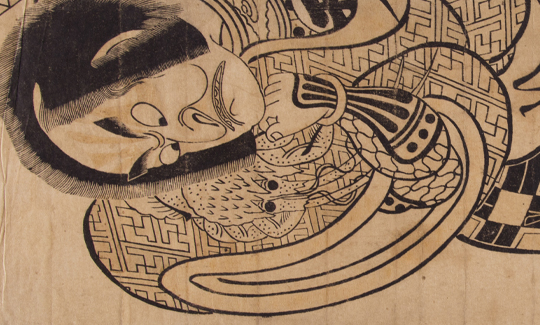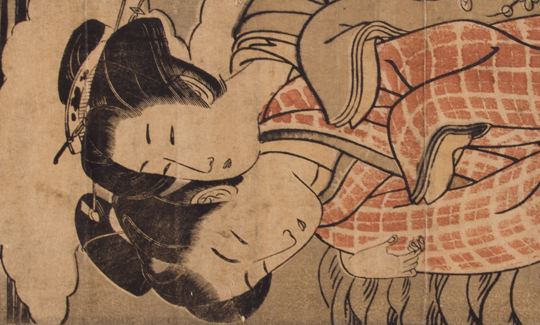Hashira-e (“pillar pictures”) are woodblock prints with specific measurements - 70 cm. long and 12 cm. wide - and were widespread in Japan from the mid-18th to mid-19th centuries. The source of these long, narrow prints and the exact dates of their provenance are not known, but it seems that they were integrated into the hanging scrolls that were traditionally used to decorate the interior supporting beams of the Japanese house, though only a few clues have been found to indicate that this was their purpose. Many of the pillar prints are in poor condition and their colours damaged perhaps because, hung on pillars, they were exposed to the wear and tear of atmospheric conditions.
It is thought that the unique format of these prints derives from the attempts of the ukiyo-e artist (ukiyo-e: pictures from the Floating World) Okumura Masanobu (1686-1764) to create the 75x25 cm. prints known as kakemono-e (“hanging scroll pictures”) using wooden panels of the wrong size. Since it was customary to decorate the tokonoma - a niche or recess in the house - with a kakemono-e, householders who could not afford a scroll painted by some renowned artist would acquire such prints instead.
Since the trunk of the cherry tree, used to make the blocks for the woodblock prints, is too narrow for the kakemono-e, the artists joined two blocks together lengthwise, and filed down the join so that it would be invisible on the print. In 1741 Masanobu apparently used boards of inferior quality to make the prints cheaper, but the water-based colours used for printing soaked into the wood, which split along the join and warped. So as not to waste these panels, the artist cut them lengthwise, thus creating prints that are only 16 cm. wide. Masanobu called these prints ‘hashira-e’, but we do not know whether he actually intended them for hanging on the pillars of the house. He sometimes signed his works with the added legend ‘inventor of the pillar print’. In 1745 the width of the hashira-e was further reduced to about 12 cm.
This long, narrow format is very unusual, and presents a real challenge for the artist as regards design and composition. For the first time, the artists represented the figure in the print as if part of it had ‘walked off’ the picture. The man or woman looks as if a vertical section of the body had been cut away, and the figure seems extremely tall. Comparison with figures in standard size prints of such artists as Suzuki Harunobu (1725?-1770) and Hosoda Eishi (1756-1829) - ôban, 25x37 cm; hosoban, 14x34 cm; chûban, 21x28 cm. - shows how much larger they are in the pillar-prints. This specific composition had a marked influence on Japanese art and on the works of western artists, including Manet, Toulouse-Lautrec and Degas.
For about a 100 years, hashira-e prints were produced by famous print artists. Among them were Torii Kiyoshige (active ca.1720-1760), Isoda Koryûsai (active ca.1764-1788), Torii Kiyomitsu (ca.1735-1785), Katsukawa Shunchô (active ca.1780-1795), Utagawa Toyonobu (active ca.1770-1780) and Kitagawa Utamaro (1753-1806). Other renowned artists, including Ando Hiroshige (1797-1858) did not produce pillar prints, and there were those who only made a few of them, such as Katsushika Hokusai (1760-1849), Utagawa Kuniyoshi (1798-1861), and Utagawa Kunisada (1786-1864).
In 1840 the artists stopped making pillar prints for some unknown reason. By comparison with the vast number of woodblock prints of standard sizes, only about 1500 hashira-e were produced, but there can be no doubt that they convey to us the finest qualities of the Japanese print.
Dr. Ilana Singer Blaine
Tikotin Museum of Japanese Art
Free entree to the exhibitions for children and youth up to the age of 18 during Sukkot (6-11.10.17)
Entrance for children up to the age of 16 is conditional upon an adult accompanied by a fee! * Children over the age of 16 can enter without an adult * The offer is not valid for groups or student visits * Excludes events and workshops



